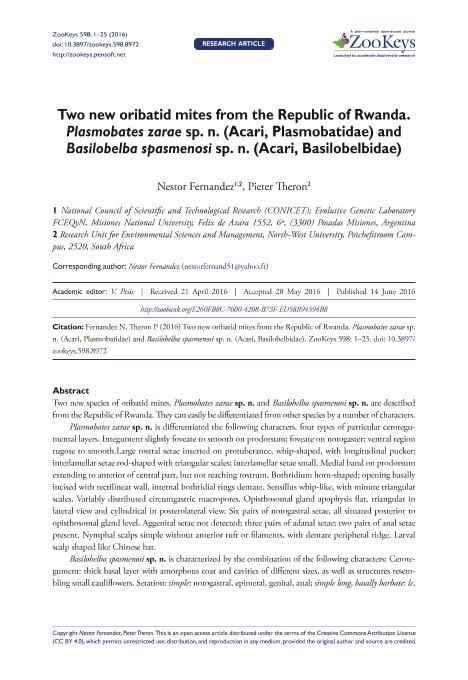Artículo
Two new oribatid mites from the Republic of Rwanda: Plasmobates zarae sp. n. (Acari, Plasmobatidae) and Basilobelba spasmenosi sp. n. (Acari, Basilobelbidae)
Fecha de publicación:
14/06/2016
Editorial:
Pensoft Publishers
Revista:
ZooKeys
ISSN:
1313-2989
e-ISSN:
1313-2970
Idioma:
Inglés
Tipo de recurso:
Artículo publicado
Clasificación temática:
Resumen
Two new species of oribatid mites, Plasmobates zarae sp. n. and Basilobelba spasmenosi sp. n. are described from the Republic of Rwanda. They can easily be differentiated from other species by a number of characters. Plasmobates zarae sp. n. is differentiated the following characters. four types of particular cerotegumental layers. Integument slightly foveate to smooth on prodorsum; foveate on notogaster; ventral region rugose to smooth.Large rostral setae inserted on protuberance, whip-shaped, with longitudinal pucker; interlamellar setae rod-shaped with triangular scales; interlamellar setae small. Medial band on prodorsum extending to anterior of central part, but not reaching rostrum. Bothridium horn-shaped; opening basally incised with rectilinear wall, internal bothridial rings dentate. Sensillus whip-like, with minute triangular scales. Variably distributed circumgastric macropores. Opisthosomal gland apophysis flat, triangular in lateral view and cylindrical in posterolateral view. Six pairs of notogastral setae, all situated posterior to opisthosomal gland level. Aggenital setae not detected; three pairs of adanal setae; two pairs of anal setae present. Nymphal scalps simple without anterior tuft or filaments, with dentate peripheral ridge. Larval scalp shaped like Chinese hat. Basilobelba spasmenosi sp. n. is characterized by the combination of the following characters: Cerotegument: thick basal layer with amorphous coat and cavities of different sizes, as well as structures resembling small cauliflowers. Setation: simple: notogastral, epimeral, genital, anal; simple long, basally barbate: le, ro setae; simple, whip-shaped: ex setae; medium length, sharpened tip with thorns on surface: in setae, leg setae; Flabellate: setae situated in ventral neotrichous zone. Thorn-like barbs and more or less parallel longitudinal grooves present on body surface of le, ro, in and leg setae. Prodorsum: rostrum finger-shaped, relative sizes of setae: le > ro > in > ex. Prodorsal cuticular surface smooth with shallow transversal furrow and two oblique furrows determining two triangular structures. Large humpbacked CSO situated anterior to and in medial line with in setal insertion, dorsal bothridial opening. Notogaster swollen, hemispheric; nine pairs of minute setae, only h1, h2, h3 easily identifiable, cuticular wart and dimple clearly visible. Humeral apophysis with longitudinal furrow dorsally. Elongate chelicera with cha, chb setae, behind them a series of scales directed dorsoventrally. Epimeral setation 3-1-3-3, adanal-aggenital neotrichy with between 8-10 setae. Nymphal scalps with very particular bean-shaped structure on either side of the decoupage zone, surrounding horn-like structure. Scalps with cuticular polyhedral reticulate to ovoid structure, often forming a cavity, either completely perforated or with a thin cuticular layer resembling an interior membrane.
Archivos asociados
Licencia
Identificadores
Colecciones
Articulos(CCT - NORDESTE)
Articulos de CTRO.CIENTIFICO TECNOL.CONICET - NORDESTE
Articulos de CTRO.CIENTIFICO TECNOL.CONICET - NORDESTE
Citación
Fernández, Néstor Alfredo; Theron, Pieter; Two new oribatid mites from the Republic of Rwanda: Plasmobates zarae sp. n. (Acari, Plasmobatidae) and Basilobelba spasmenosi sp. n. (Acari, Basilobelbidae); Pensoft Publishers; ZooKeys; 2016; 598; 14-6-2016; 1-25
Compartir
Altmétricas




